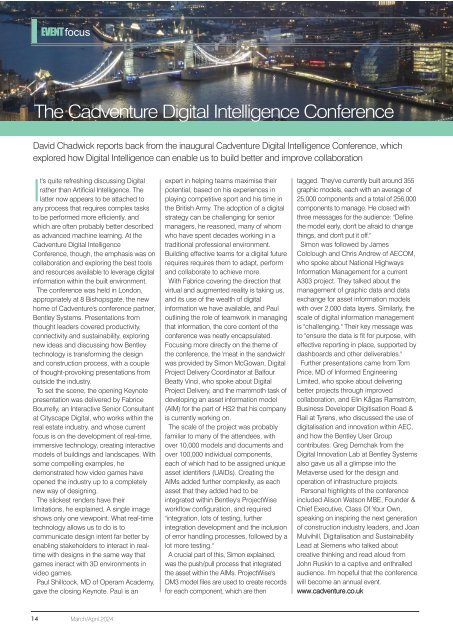You also want an ePaper? Increase the reach of your titles
YUMPU automatically turns print PDFs into web optimized ePapers that Google loves.
EVENTfocus<br />
The Cadventure Digital Intelligence Conference<br />
David Chadwick reports back from the inaugural Cadventure Digital Intelligence Conference, which<br />
explored how Digital Intelligence can enable us to build better and improve collaboration<br />
It's quite refreshing discussing Digital<br />
rather than Artificial Intelligence. The<br />
latter now appears to be attached to<br />
any process that requires complex tasks<br />
to be performed more efficiently, and<br />
which are often probably better described<br />
as advanced machine learning. At the<br />
Cadventure Digital Intelligence<br />
Conference, though, the emphasis was on<br />
collaboration and exploring the best tools<br />
and resources available to leverage digital<br />
information within the built environment.<br />
The conference was held in London,<br />
appropriately at 8 Bishopsgate, the new<br />
home of Cadventure's conference partner,<br />
Bentley Systems. Presentations from<br />
thought leaders covered productivity,<br />
connectivity and sustainability, exploring<br />
new ideas and discussing how Bentley<br />
technology is transforming the design<br />
and construction process, with a couple<br />
of thought-provoking presentations from<br />
outside the industry.<br />
To set the scene, the opening Keynote<br />
presentation was delivered by Fabrice<br />
Bourrelly, an Interactive Senior Consultant<br />
at Cityscape Digital, who works within the<br />
real estate industry. and whose current<br />
focus is on the development of real-time,<br />
immersive technology, creating interactive<br />
models of buildings and landscapes. With<br />
some compelling examples, he<br />
demonstrated how video games have<br />
opened the industry up to a completely<br />
new way of designing.<br />
The slickest renders have their<br />
limitations, he explained, A single image<br />
shows only one viewpoint. What real-time<br />
technology allows us to do is to<br />
communicate design intent far better by<br />
enabling stakeholders to interact in realtime<br />
with designs in the same way that<br />
games ineract with 3D environments in<br />
video games.<br />
Paul Shillcock, MD of Operam Academy,<br />
gave the closing Keynote. Paul is an<br />
expert in helping teams maximise their<br />
potential, based on his experiences in<br />
playing competitive sport and his time in<br />
the British Army. The adoption of a digital<br />
strategy can be challenging for senior<br />
managers, he reasoned, many of whom<br />
who have spent decades working in a<br />
traditional professional environment.<br />
Building effective teams for a digital future<br />
requires requires them to adapt, perform<br />
and collaborate to achieve more.<br />
With Fabrice covering the direction that<br />
virtual and augmented reality is taking us,<br />
and its use of the wealth of digital<br />
information we have available, and Paul<br />
outlining the role of teamwork in managing<br />
that information, the core content of the<br />
conference was neatly encapsulated.<br />
Focusing more directly on the theme of<br />
the conference, the 'meat in the sandwich'<br />
was provided by Simon McGowan, Digital<br />
Project Delivery Coordinator at Balfour<br />
Beatty Vinci, who spoke about Digital<br />
Project Delivery, and the mammoth task of<br />
developing an asset information model<br />
(AIM) for the part of HS2 that his company<br />
is currently working on.<br />
The scale of the project was probably<br />
familiar to many of the attendees, with<br />
over 10,000 models and documents and<br />
over 100,000 individual components,<br />
each of which had to be assigned unique<br />
asset identifiers (UAIDs). Creating the<br />
AIMs added further complexity, as each<br />
asset that they added had to be<br />
integrated within Bentley's ProjectWise<br />
workflow configuration, and required<br />
"integration, lots of testing, further<br />
integration development and the inclusion<br />
of error handling processes, followed by a<br />
lot more testing."<br />
A crucial part of this, Simon explained,<br />
was the push/pull process that integrated<br />
the asset within the AIMs. ProjectWise's<br />
DM3 model files are used to create records<br />
for each component, which are then<br />
tagged. They've currently built around 355<br />
graphic models, each with an average of<br />
25,000 components and a total of 256,000<br />
components to manage. He closed with<br />
three messages for the audience: "Define<br />
the model early, don't be afraid to change<br />
things, and don't put it off."<br />
Simon was followed by James<br />
Colclough and Chris Andrew of AECOM,<br />
who spoke about National Highways<br />
Information Management for a current<br />
A303 project. They talked about the<br />
management of graphic data and data<br />
exchange for asset information models<br />
with over 2,000 data layers. Similarly, the<br />
scale of digital information management<br />
is "challenging." Their key message was<br />
to "ensure the data is fit for purpose, with<br />
effective reporting in place, supported by<br />
dashboards and other deliverables."<br />
Further presentations came from Tom<br />
Price, MD of Informed Engineering<br />
Limited, who spoke about delivering<br />
better projects through improved<br />
collaboration, and Elin Kågas Ramström,<br />
Business Developer Digitisation Road &<br />
Rail at Tyrens, who discussed the use of<br />
digitalisation and innovation within AEC,<br />
and how the Bentley User Group<br />
contributes. Greg Demchak from the<br />
Digital Innovation Lab at Bentley Systems<br />
also gave us all a glimpse into the<br />
Metaverse used for the design and<br />
operation of infrastructure projects.<br />
Personal highlights of the conference<br />
included Alison Watson MBE, Founder &<br />
Chief Executive, Class Of Your Own,<br />
speaking on inspiring the next generation<br />
of construction industry leaders, and Joan<br />
Mulvihill, Digitalisation and Sustainability<br />
Lead at Siemens who talked about<br />
creative thinking and read aloud from<br />
John Ruskin to a captive and enthralled<br />
audience. I'm hopeful that the conference<br />
will become an annual event.<br />
www.cadventure.co.uk<br />
14<br />
March/April 2024

















